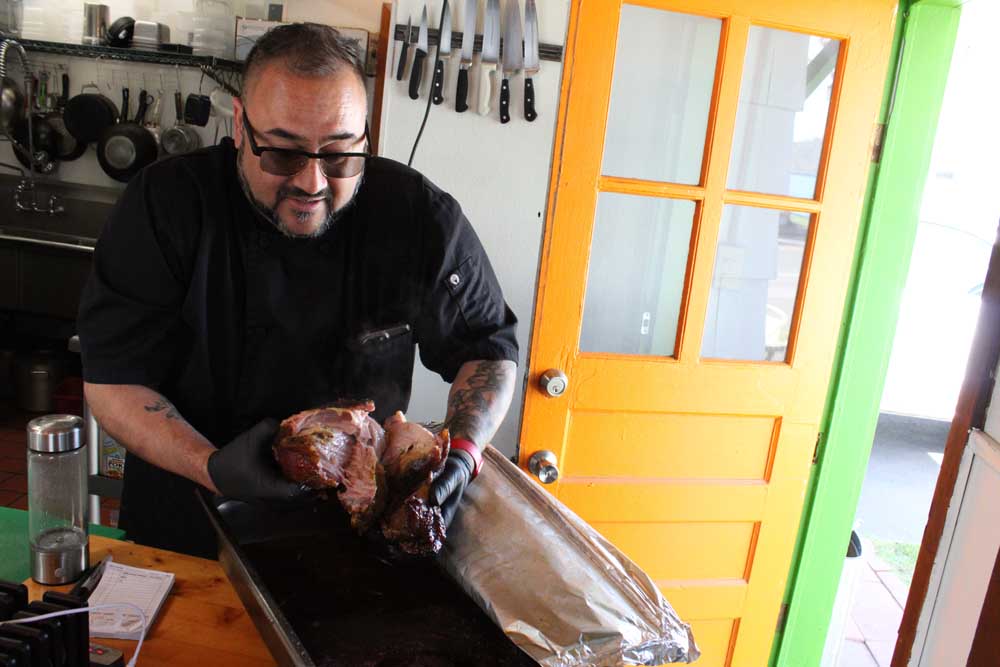From food truck to brick and mortar: Restaurateurs savor their new spaces
Published 9:00 am Tuesday, April 23, 2024

- Indus Johnston shows off pork he cooked overnight on April 23, one of several proteins he offers in his dishes at Taco Wok, located in downtown Long Beach.
LONG BEACH PENINSULA — For Indus Johnston and Sierra Briggs, gone are those cold days of winter and warm days of summer packed tight inside not-so-spacious food trucks, regularly working hours long after closing just to try and keep up with the daily grind.
Trending
In recent months, Johnston, who formerly operated Long Beach Dragon Bowls at the lot along Sid Snyder Drive, and Briggs, who ran Sierra’s Place out of a Seaview gas station parking lot, have made the plunge and swapped in their food trucks for places of their own — and there’s been no looking back.
“At first it was kind of scary, but once we committed it’s just so much more comfortable now,” said Johnston. “When you come in and sit down, that’s one of my favorite parts; folks who feel comfortable to stay and eat, hang out, have a conversation and they’re walking out the door cracking up, feeling good and full.”
‘Our five-year plan was to get into a building, and we did it in two … I wanted to go back into a building and I absolutely love the peninsula. When this place opened up, I jumped on it.’
Trending
Sierra Briggs, owner of Sierra’s Place in Ocean Park
Indus and his wife, Aimee, now run Taco Wok out of the former Streetside Taco building at 609 Pacific Ave. in Long Beach. Briggs runs her cafe, still named Sierra’s Place, at 1513 Bay Ave. in Ocean Park, a building that has previously housed Barbequeen and Berry Patch.
Always the goal
For both restaurateurs, eventually operating a brick and mortar location of their own had been the goal all along when they first set out and opened their food trucks.
Johnston, a well-known local chef who previously helmed The Cove’s kitchen before launching Long Beach Dragon Bowls, had been close to opening his own spot in the past before this opportunity arose.
“I felt like [the food truck] was going to be a stepping stone,” said Johnston. “I thought I would have more fun in there, which I did during the summer.”
Briggs, who previously ran The Old Fishtrap in Chinook, set a goal of opening her own location within five years; she accomplished it in two. “Our five-year plan was to get into a building, and we did it in two … I wanted to go back into a building and I absolutely love the peninsula. When this place opened up, I jumped on it.”
Their next five-year plan? Owning the building, rather than just leasing. Briggs is currently leasing the property from the Port of Peninsula. The interior of the building has undergone a lot of work since Briggs and her team took it over, and they also wanted to brighten it up to help match a cafe environment.
Breathing room
The differences between operating a food truck and a physical location are many, they both said, and mostly for the better. The most obvious, perhaps, is the square footage they now have to work with compared to the tight quarters of their food trucks.
At Sierra’s Place, the extra space and appliances in their new building has been hugely beneficial.
“I have a lot more space here, which means I’ve really opened up and evolved my menu,” Briggs said. “We’ve added a lot of things [to the menu] and we’ve got ovens here, which is nice. It’s a huge advantage.”
Even Taco Wok’s modestly sized building offers some much-needed breathing room. The kitchen space is roughly similar to the food truck that Johnston worked out of, but the narrowness of the food truck proved to be a hindrance and was tough to navigate with multiple people working inside it. In their new building, there’s less of a worry about, say, accidentally delivering — or receiving — an elbow to the face.
“He stays over [in the kitchen] doing his thing, and I stay over here doing my thing,” said Aimee, who takes and processes orders.
Chance to connect
That ability to connect and have conversations with customers has also been a much welcomed development for both Johnston and Briggs, who said they felt somewhat isolated in their food trucks from the people buying their product.
“It’s so nice, especially the locals,” said Johnston. “They come in and they hang out. We have fun, [me and Aimee] are bantering back and forth and they love it.”
While he enjoyed those busy summer months at the food truck, winter had the opposite effect. “I had a good time because it was totally new, but it got really claustrophobic when we slowed down and it came to the winter time. It got lonely in there; it was slow enough that I could do it by myself during the winter, but that’s no fun.”
Briggs said she’s been able to see a lot more customers working out of their new building and that business has been much more consistent compared to the up-and-down nature of working out of a food truck, which is much more dependent on the weather’s cooperation.
“It’s a better economy in a building because we have a better opportunity for volume,” she added. “Business has been insane, and we’re still winding up for the busy season.”
More freedom
Since opening Taco Wok, Johnston has been able to expand on the menu he had at Long Beach Dragon Bowls, which had a focus on asian fusion dishes.
“We were restricted by a non-compete [agreement], and all of us had to sign a non-compete over there,” Indus said regarding the other food trucks that operated on the lot, which ballooned from two when they first opened to five by the time they made the transition to Taco Wok. The intent of the non-compete agreement was to prevent multiple food trucks from offering similar dishes — although what constituted “similar” was a point of contention.
‘It’s so nice, especially the locals,” said Johnston. “They come in and they hang out. We have fun, [me and Aimee] are bantering back and forth and they love it.’
Indus Johnston, owner of Taco Wok in Long Beach
He said the agreement restricted what he could put on his menu, like tacos, which he’s able to offer a variety of now along with other new dishes and some fan-favorite holdovers from Long Beach Dragon Bowls.
“It just felt like we were starting to get closed in, and in here there’s this fluidity with us” and what they can offer, said Aimee.
At Sierra’s Place, Briggs said she hopes to be able to begin offering beer and wine as soon as this summer, and the deck has already been opened up for seating. They’re also planning to begin running a dinner service on the weekend, as well as a Sunday brunch service.
“It’s still mostly breakfast, but we also do lunch and eventually we’ll open up Friday and Saturday nights for dinner,” Briggs added.
Both Briggs and the Johnstons also pointed to the fact that they don’t have to go out and shop for their own products as regularly now, due to either having distributors or more space to store product in their new buildings. That change alone can save hours on a daily basis and helps even out their work-life balance.
For Briggs, who owned and has since sold her food truck, the only major downside of making the move to brick and mortar is not being able to drive and meet customers where they’re at now, such as festivals and other community events.
“I can’t move the building to Kite Week,” she joked.









